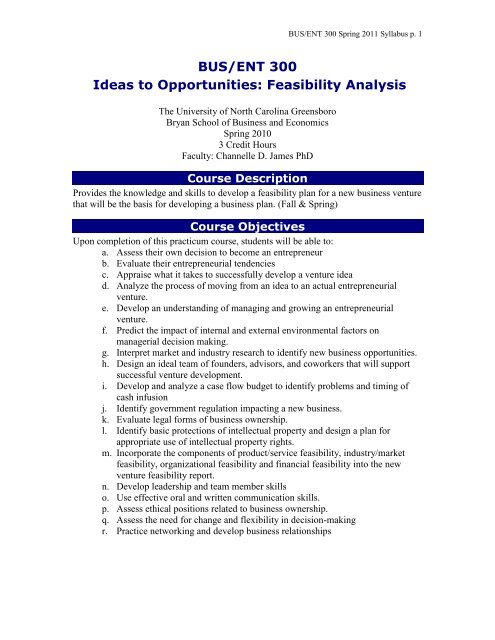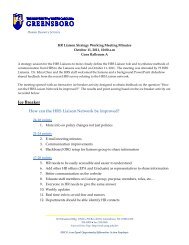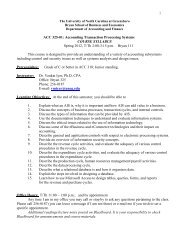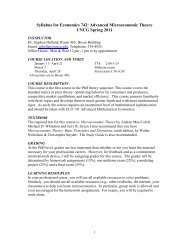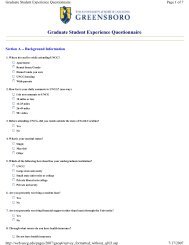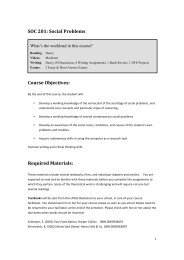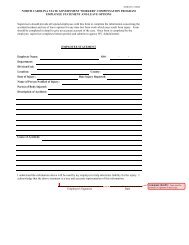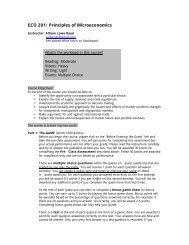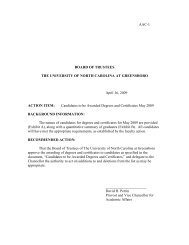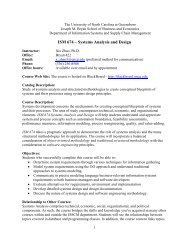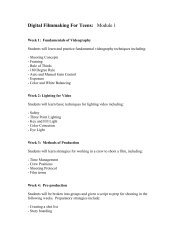BUS 300-01 - The University of North Carolina at Greensboro
BUS 300-01 - The University of North Carolina at Greensboro
BUS 300-01 - The University of North Carolina at Greensboro
- No tags were found...
You also want an ePaper? Increase the reach of your titles
YUMPU automatically turns print PDFs into web optimized ePapers that Google loves.
<strong>BUS</strong>/ENT <strong>300</strong> Spring 2<strong>01</strong>1 Syllabus p. 4870-899830-869800-829770-799730-769700-729670-699600-669000-599B+BB-C+CC-D+DF1.Barringer and IrelandEntrepreneurshipISBN-10: <strong>01</strong>36083536ISBN-13: 978<strong>01</strong>36083535Your Reading M<strong>at</strong>erial2.Fast Trac Booklet and S<strong>of</strong>twareVenture Planning Workbook 2004 EditionCourse OutlineBelow is an outline <strong>of</strong> the content and activities in each unit <strong>of</strong> the course.Course HomeCourse SyllabusInstructor Inform<strong>at</strong>ionCourse DescriptionCourse ObjectivesGrade bookYour Reading M<strong>at</strong>erialPoliciesOnline Communic<strong>at</strong>ions GuidelinesInstructor's OfficeEmail and AIMModule 1: Wh<strong>at</strong> is Entrepreneurship?Reading: Barringer Chapter1,7,12Module 2 : Feasibility Analysis Process
<strong>BUS</strong>/ENT <strong>300</strong> Spring 2<strong>01</strong>1 Syllabus p. 5Reading Barringer Chapter 3,Module 3 Opportunity Recognition & Entrepreneurial ResearchReading Barringer Chapter 2,Module 4 : : Cre<strong>at</strong>ing Your Idea – Preliminary ModelReading Barringer Chapter 6,Module 5 : Defining your IndustryReading Barringer Chapter 5,Module 6 : Market Who?ReadingModule 7 : Financial ResearchReading Barringer Chapter 8, 10Module 8 : Competitive AnalysisReading TBAModule 9 : Venture Structure and the FutureReading Barringer Chapter 9,13,14,15Module 10 : Just an Idea or an Opportunity?: AnalysisReadings TBAModule 11 : Present<strong>at</strong>ionScheduleD<strong>at</strong>esJanuary 10, 2<strong>01</strong>1January 12, 2<strong>01</strong>1January 17, 2<strong>01</strong>1Topics, Assignments, and ReadingsCourse IntroductionModule 1: Wh<strong>at</strong> is EntrepreneurshipDr. Martin Luther King Jr. HolidayJanuary 19, 2<strong>01</strong>1January 24, 2<strong>01</strong>1January 26, 2<strong>01</strong>1Module 1: Wh<strong>at</strong> is EntrepreneurshipPortfolio Entry Due by 11:59 pmOn-line quiz to be completed between January19 <strong>at</strong> 5pm –January 22 <strong>at</strong> 5pm.Module 2 : Feasibility Analysis ProcessModule 2 : Feasibility Analysis ProcessJanuary 31, 2<strong>01</strong>1Module 2 : Feasibility Analysis ProcessPortfolio Entry Due by 11:59 pmOn-line quiz to be completed between January 31 <strong>at</strong> 5pm –February 3 <strong>at</strong> 5pm.Module 3 Opportunity Recognition &Entrepreneurial Research
<strong>BUS</strong>/ENT <strong>300</strong> Spring 2<strong>01</strong>1 Syllabus p. 6February 2, 2<strong>01</strong>1Module 3 Opportunity Recognition &Entrepreneurial ResearchFebruary 7, 2<strong>01</strong>1 Module 3 Opportunity Recognition &Entrepreneurial ResearchPortfolio Entry Due by 11:59 pmOn-line quiz to be completed between February 7 <strong>at</strong> 5pm –February 10 <strong>at</strong> 5pm.February 9, 2<strong>01</strong>1 Module 4 : : Cre<strong>at</strong>ing Your Idea –Preliminary ModelFebruary 14, 2<strong>01</strong>1 Module 4 : : Cre<strong>at</strong>ing Your Idea –Preliminary ModelPortfolio Entry Due by 11:59 pmOn-line quiz to be completed between February14 <strong>at</strong> 5pm –February 17 <strong>at</strong> 5pm.February 16, 2<strong>01</strong>1 Module 5 : Defining your IndustryFebruary 21, 2<strong>01</strong>1February 23, 2<strong>01</strong>1February 28, 2<strong>01</strong>1March 2, 2<strong>01</strong>1March 7, 2<strong>01</strong>1March 9, 2<strong>01</strong>1March 14, 2<strong>01</strong>1March 16, 2<strong>01</strong>1March 21, 2<strong>01</strong>1March 23, 2<strong>01</strong>1March 28, 2<strong>01</strong>1Module 5 : Defining your IndustryModule 5 : Defining your IndustryPortfolio Entry Due by 11:59 pmOn-line quiz to be completed between February 23 <strong>at</strong> 5pm –February 26 <strong>at</strong> 5pm.Module 6 : Market Who?Module 6 : Market Who?Spring BreakSpring BreakModule 6 : Market Who?Portfolio Entry Due by 11:59 pmOn-line quiz to be completed between March 14 <strong>at</strong> 5pm –March 17 <strong>at</strong> 5pm.Module 7 : Financial ResearchModule 7 : Financial ResearchModule 7 : Financial ResearchModule 7 : Financial ResearchPortfolio Entry Due by 11:59 pm
<strong>BUS</strong>/ENT <strong>300</strong> Spring 2<strong>01</strong>1 Syllabus p. 7March 30, 2<strong>01</strong>1April 4, 2<strong>01</strong>1April 6, 2<strong>01</strong>1April 11, 2<strong>01</strong>1April 13, 2<strong>01</strong>1April 18, 2<strong>01</strong>1April 20, 2<strong>01</strong>1April 25, 2<strong>01</strong>1April 28, 2<strong>01</strong>1May 2, 2<strong>01</strong>13:30pm – 6:30pmOn-line quiz to be completed between March 28 <strong>at</strong> 5pm –March 31 <strong>at</strong> 5pm.Module 8 : Competitive AnalysisModule 8 : Competitive AnalysisModule 8 : Competitive AnalysisPortfolio Entry Due by 11:59 pmOn-line quiz to be completed between April 6 <strong>at</strong> 5pm – April 9<strong>at</strong> 5pm.Module 9 : Venture Structure and the FutureModule 9 : Venture Structure and the FuturePortfolio Entry Due by 11:59 pmOn-line quiz to be completed between April 13 <strong>at</strong> 5pm – April16 <strong>at</strong> 5pm.Module 10 : Just an Idea or anOpportunity?: AnalysisModule 10 : Just an Idea or anOpportunity?: AnalysisPortfolio Entry Due by 11:59 pmOn-line quiz to be completed between April 20 <strong>at</strong> 5pm – April23 <strong>at</strong> 5pm.Special Present<strong>at</strong>ion – Sharpen Your Present<strong>at</strong>ion SkillsFeasibility Study Due by 5pm and must be delivered to my<strong>of</strong>ficeFinal Present<strong>at</strong>ions*See UNCG Final Exam Schedule for d<strong>at</strong>e <strong>of</strong> present<strong>at</strong>ion. You will be informed <strong>of</strong> thepresent<strong>at</strong>ion schedule during the course. Your team will sign up for a time to present infrom <strong>of</strong> your Board <strong>of</strong> Investors. Once your team sign up for a time you will be instructedwhere to meet on the day <strong>of</strong> final exams. You must dress pr<strong>of</strong>essionally for yourpresent<strong>at</strong>ion.PoliciesInstructor’s Grading Criteria/Timetable: All course projects will be graded within oneweek <strong>of</strong> their due d<strong>at</strong>e. L<strong>at</strong>e projects will not be accepted for the course. Please reviewthe instructions and the due d<strong>at</strong>es on the calendar. L<strong>at</strong>e work will not be accepted.
<strong>BUS</strong>/ENT <strong>300</strong> Spring 2<strong>01</strong>1 Syllabus p. 8Naming Conventions: In order to facilit<strong>at</strong>e the tracking <strong>of</strong> correspondence with theinstructor, please use the following naming conventions (username is your UNCGusername-assignment module #). Email Subject Lines: Please start your subject lines in email correspondencewith Course & section username: SUBJECT_OF_MESSAGEExtenu<strong>at</strong>ing Circumstances: If you have extenu<strong>at</strong>ing circumstances rel<strong>at</strong>ed to thiscourse you should contact the instructor immedi<strong>at</strong>ely by email. Just because you have anextenu<strong>at</strong>ing circumstance does not mean th<strong>at</strong> you will be allowed to make up assignmentsor neg<strong>at</strong>e the impact <strong>of</strong> not <strong>at</strong>tending a class. You will be given consider<strong>at</strong>ion for legalmedical or psychological reasons th<strong>at</strong> have been formally documented. If you haveextenu<strong>at</strong>ing circumstances th<strong>at</strong> prevent you from completing projects, exams orparticip<strong>at</strong>ing in the class, please contact the instructor to make altern<strong>at</strong>ive arrangements.<strong>The</strong> possibility <strong>of</strong> altern<strong>at</strong>ive arrangements is <strong>at</strong> the discretion <strong>of</strong> the instructor. Activecommunic<strong>at</strong>ion is the key to overcoming any hurdles you may encounter during the term.Attendance Policy: Students must come to every session <strong>of</strong> this course. If you areabsent from class you will miss 5 points <strong>of</strong> your final grade for each class missed. After3 missed classes you will be autom<strong>at</strong>ically dropped from the course. Inform<strong>at</strong>ion missedwhile you are absent from class will not be reviewed. If you miss class you may beprevented from particip<strong>at</strong>ing in future class activities and assignments. You will be givenconsider<strong>at</strong>ion for legal medical or a psychological reason th<strong>at</strong> have been formallydocumented but th<strong>at</strong> does not mean th<strong>at</strong> you will not have penalties associ<strong>at</strong>ed with yourfinal grade.Online Communic<strong>at</strong>ions GuidelinesNetiquetteOften interactions for this course are in written form. Your comfort level with expressingideas and feelings in writing will add to your success in any form <strong>of</strong> communic<strong>at</strong>ion. <strong>The</strong>ability to write is necessary, but you also need to understand wh<strong>at</strong> is consideredappropri<strong>at</strong>e when communic<strong>at</strong>ing online.A Few Rules <strong>of</strong> ThumbWait to respond to a message th<strong>at</strong> upsets you and be careful <strong>of</strong> wh<strong>at</strong> you say and how yousay it.Be consider<strong>at</strong>e. Rude or thre<strong>at</strong>ening language, inflamm<strong>at</strong>ory assertions (<strong>of</strong>ten referred toas "flaming"), personal <strong>at</strong>tacks, and other inappropri<strong>at</strong>e communic<strong>at</strong>ion will not betoler<strong>at</strong>ed.Never post a message th<strong>at</strong> is in all capital letters -- it comes across to the reader asSHOUTING!Use boldface and italics sparingly, as they can denote sarcasm.
<strong>BUS</strong>/ENT <strong>300</strong> Spring 2<strong>01</strong>1 Syllabus p. 9Keep messages short and to the point.Always practice good grammar, punctu<strong>at</strong>ion, and composition. This shows th<strong>at</strong> you'vetaken the time to craft your response and th<strong>at</strong> you respect your classm<strong>at</strong>es' work.Be respectful and tre<strong>at</strong> everyone as you would want to be tre<strong>at</strong>ed yourself.Use spell check!Course PortfolioYour course Portfolio is loc<strong>at</strong>ed in Blackboard and is labeled “Team Portfolios”. Pleasemake sure th<strong>at</strong> review the procedures for using the portfolio. Make sure to edit yourwork. For each module you will be asked to upload your portfolio entry into Blackboard.With each new entry you should upload the whole revised documents. Do not add entriesafter the module is closed and completed.Make sure your writing is clear. Refer to specific passages or ideas in the course or textth<strong>at</strong> have sparked your interest.Make sure your contribution adds something new to the m<strong>at</strong>erial presented to you inclass.Make your posting clear and easy to follow by dividing longer messages into paragraphs.Use correct spelling, capitaliz<strong>at</strong>ion, grammar, syntax, and punctu<strong>at</strong>ion.Paper SubmissionsAPA manuscript style dict<strong>at</strong>es how your paper should appear on the page.<strong>The</strong>re are two types <strong>of</strong> APA manuscripts: copy manuscripts (those submitted forpublic<strong>at</strong>ion) and final manuscripts (those not submitted for public<strong>at</strong>ion). Copymanuscripts are much more formal and may contain multiple sections. Specifically, theywill have an abstract (a one-paragraph summary <strong>of</strong> the paper). <strong>The</strong> papers you producefor this class will be final manuscripts. Unlike copy manuscripts, final manuscripts donot, unless specifically required by an instructor, require an abstract. <strong>The</strong>y do include: A title page <strong>The</strong> paper itself (the "discussion") A references pageA title page contains three items: a running head (a short version <strong>of</strong> the title), the paper'stitle, and the author's name. Traditionally, the author's affili<strong>at</strong>ion (the university he or she<strong>at</strong>tends or works for) appears below the author's name; however, many college instructorsprefer students to put the course and section number in this place (since we all knowwhich institution we are <strong>at</strong>). <strong>The</strong> running title appears in the top right corner <strong>of</strong> every
<strong>BUS</strong>/ENT <strong>300</strong> Spring 2<strong>01</strong>1 Syllabus p. 10page, including the title page, right before the page number. <strong>The</strong> title, the author's name,and the author's affili<strong>at</strong>ion (or course and section number) appear in the center <strong>of</strong> the titlepage.Form<strong>at</strong>ting the discussion, or body, <strong>of</strong> the paper, is also quite straightforward. APA finalmanuscripts are generally double-spaced (unless your instructor requests otherwise). Asmentioned above, the running head appears in the top right corner <strong>of</strong> each page, rightbefore the page number. <strong>The</strong> full title also appears, but only on the first page <strong>of</strong> thediscussion. For subsequent pages, the running head is the only "title" present.New paragraphs should be indented (which is the default setting for the Tab key) andthere should not be an extra blank line between paragraphs.<strong>The</strong> last thing required is the references page. This page, like the others, has the runninghead and page number in the upper-right hand corner. Sources should be alphabetized bythe author's last name (or, for sources without authors, by the first letter in the title) andthe second line <strong>of</strong> each source should be indented a half inch (the first line is notindented).Here are a few additional form<strong>at</strong>ting standards to keep in mind: Use standard margins: 1" on all sides. Use standard 12-point font size. Use standard double-spacing: average <strong>of</strong> 22 lines per page, and between 20and 24 lines per page. Use left-aligned text. Do not right-justify. <strong>The</strong>re should be no subtitles or spaces between paragraphs within the paper. When citing a quote <strong>of</strong> more than four lines, you should indent the entirequoted passage 10 spaces from the left margin. It is not necessary to indentthese block quotes from the right margin. Continue with the usual doublespacing,and give the usual acknowledgements <strong>at</strong> the end <strong>of</strong> the quote. Blockquotes do not require quot<strong>at</strong>ion marks.*Syllabus based on a templ<strong>at</strong>e from Micros<strong>of</strong>t Office.


